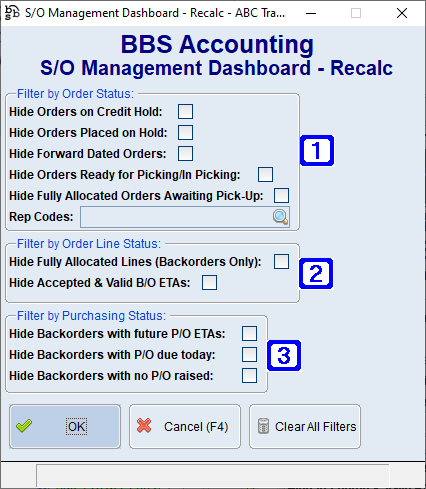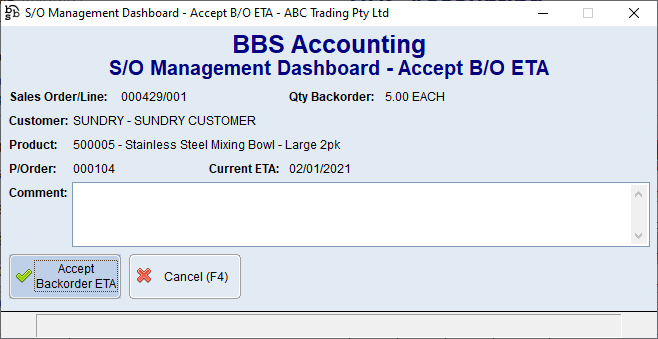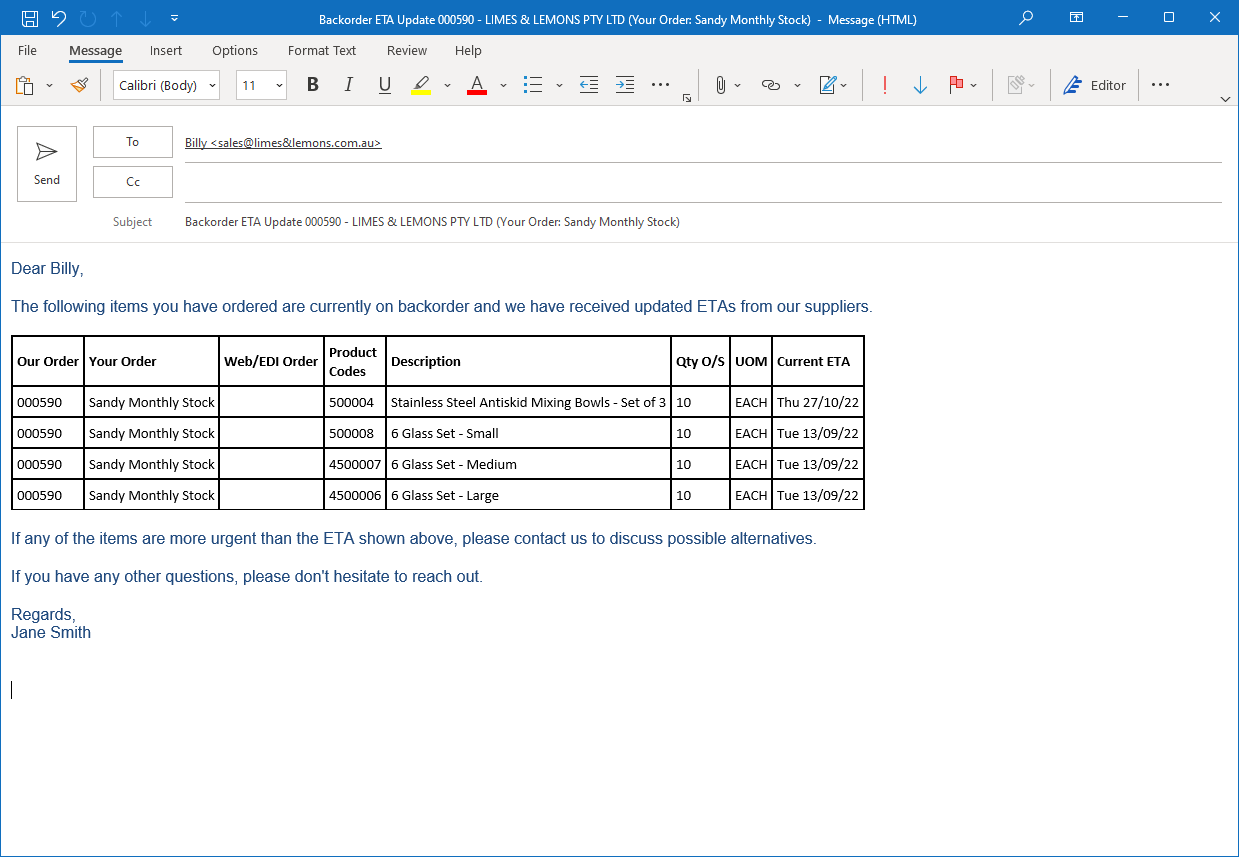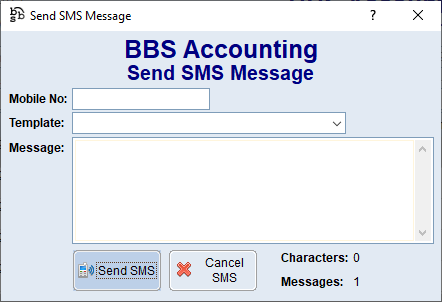|
Main Menu > Sales Ordering > Sales Order Management Dashboard |
The Sales Order Management Dashboard allows users to view the status of all outstanding sales orders, filter for only specific orders based on their status, and accept calculated backorder ETA's from suppliers.
This screen can be useful to find sales orders that fall into certain categories. Some examples are:
1.Orders that have been flagged as 'on hold' and have been forgotten about
2.Orders that are awaiting pick-up where it may be necessary to remind the customer to pick-up the goods
3.Orders that have backorder items that haven't been ordered yet
4.Orders that have backorder items and the customer needs to be advised of the backorder ETA (and then that backorder ETA can be 'accepted' so that all users can see the customer has been notified)
5.Orders that have backorder ETAs that have passed but the product has not been received
6.Orders that have been removed from a picking run when they are fully allocated and have not been despatched
7.No Part Ship orders with some stock allocated that could be set to Part Ship OK to release the goods in stock
8.Direct delivery orders that have been receipted but not invoiced.
The options chosen by users when the screen is recalculated can be used to filter for orders that fall into the category they would like to view.
Recalc:
When the screen is first opened, the recalc screen will appear to allow users to filter for the outstanding sales orders they wish to view. Sales orders can be filtered out based on their status, or certain sales order lines can be filtered out based on their status.
NOTE: In the event an entire order is filtered out, or all line items on an order are filtered out, the sales order will not appear in the screen at all.

S/O Management Dashboard Recalc Screen
Filtering by order status |
|
|
▪Hide Orders on Credit Hold - Will hide sales orders currently on credit hold ▪Hide Orders Placed on Hold - Will hide sales orders currently placed on hold ▪Hide Forward Dated Orders - Will hide sales orders with a future pick date/time ▪Hide Orders Ready for Picking/In Picking - Will hide sales orders that are in the queue ready to print on a picking run, and orders currently on a picking run ▪Hide Fully Allocated Orders Awaiting Pick-Up - Will hide sales orders that are fully allocated, have been removed from a picking run, and have the words ‘pickup’ or ‘pick-up’ in the Ship Via field ▪Rep Codes – Allows users to select one or more sales rep codes to show only sales orders for those rep codes (blank = all) ▪Mkt Codes- Allows users to select one or more market codes to show only sales orders for those market codes (blank = all) ▪Cust Grps - Allows users to select one or more customer groups to show only sales orders for those customer groups (blank = all) |
Filtering by sales order line status |
|
|
▪Hide Fully allocated Lines (Backorders Only) - Will hide sales order lines that are fully allocated and will display backorder lines only ▪Hide Accepted & Valid B/O ETA's - Will hide sales order lines where the supplier ETA has been accepted and this ETA has not been changed to a future date since it has been accepted |
Filtering sales order lines by their purchasing status |
|
|
▪Hide Backorders with future P/O ETA's - Will hide all backorder sales order lines where the associated P/O line has a delivery date in the future ▪Hide Backorders with P/O due today - Will hide all backorder sales order lines where the associated P/O line has a delivery date of today ▪Hide Backorders with no P/O raised - Will hide all backorder sales order lines where no associated P/O can be found (ie the item has not been ordered yet) |
Calculating the ETA date for sales order backorder lines:
In order to ascertain an ETA date for each sales order line, BBS goes through a process to calculate which P/O line will likely be allocated to which S/O line on receipt. Where there is only a single backorder and single purchase order line for a product, this will always be accurate. Where there are multiple backorders and/or purchase orders for a product, BBS will sort all outstanding purchase order lines by their expected delivery date and then assume that they will be receipted in that order and allocated to sales order backorder lines following all the same rules for stock allocation that occur during actual Stock Receipting. The rules are:
1.Sales orders are allocated in order based on pick date
2.Sales orders specifically mentioned on purchase order lines in the 'Order For' field take precedence over other backorders for a given product (ie priority stock allocation)
3.EBI P/O's allocate to their linked sales orders first, and then any additional stock is allocated to other sales orders accordingly
4.Stock is only allocated to an EBI sales order from its linked purchase order(s)
5.D/D P/O's only allocate to their linked sales orders
This logic should give a fairly accurate indication of which purchase order is destined to allocate stock to a given sales order backorder line, however changes to outstanding purchase orders (eg lines cancelled, or quantities changed) could cause a reshuffle of expected stock allocations causing ETA dates to change.

Sales Order Management Dashboard Screen
|
W/H Code – Allows users to select a warehouse to work with or all warehouses |
|
Recalc (F3) – Allows users to edit the selected filter options and recalculate the screen based on the latest data available |
|
Last Calc – Displays the date, time and user of when the last recalc was performed |
|
Ship Type – Users can choose to filter sales orders via ship type, options are All, Part Ship Only, No Part Ship Only, Part & No Part Ship and Direct Delivery. Selecting a Ship Type filter will return results based on the selected filters in the Recalc screen and the ship type chosen. |
|
Ship Via - Users can choose to filter sales orders by ship via method, clicking the drop-down arrow will display a list of ship via methods. Selecting a Ship Via filter will return results based on the selected filters in the Recalc screen and the ship via method chosen. |
|
Search – Searches the Outstanding Sales Orders list box for the entered word/s |
|
Outstanding Sales Orders– Displays a list of outstanding sales orders based on the filters selected Order - Displays the sales order number Ordered - Displays the date and time the sales order was placed Pick Date - Displays the date the sales order was set to be picked Customer - Displays the customer code, name and the delivery suburb on the sales order Rep - Displays the Rep code on the sales order Alloc Ln - Displays the number of sales order lines that have had stock fully or partially allocated to them B/O Ln - Displays the number of sales order lines that have backordered stock Type - Displays the ship type Ship Via - Displays how the sales order is to be shipped Status - The status column will display the calculated status of the order. The top line will display either 'Order' for an order that has not been despatched yet, or 'Backorder (x invoices)' for an order where part has already been despatched. The second line will display one of the following notations. Where a sales order fits more than one of the criteria below, the first valid status in the list below will be displayed for the order. ▪*ON HOLD* - the sales order has been placed on hold by a user ▪*CREDIT HELD* - the sales order is currently in credit hold ▪In Picking – the sales order is currently on a picking run ▪Waiting for stock – the sales order is set to No Part Ship and has backordered lines that are preventing it from being added to a picking run ▪Picked - Awaiting Confirmation - the sales order has been picked awaiting confirmation/invoicing or; The sales order is set to Part Ship OK and all items are on backorder ▪Ready for Picking – the sales order is fully allocated and is in the queue for adding to a picking run ▪Ready for Part-Picking – the sales order is partially allocated and is in the queue for adding to a picking run ▪Ready for Invoicing – the sales order is a fully allocated direct delivery sales order and is awaiting invoice ▪Ready for Part-Invoicing – the sales order is a partially allocated direct delivery sales order and is awaiting invoice ▪Forward Dated – the sales order is either fully or partially allocated but has a future pick date ▪Picking run remove reason - Sales orders that are not in the queue for adding to a picking run, and do not fit any of the criteria above will display the reason selected the last time the sales order was removed from the picking run (if one exists) ▪No B/O – Ready to Invoice – the sales order is fully allocated, is not in the queue to be added to a picking run, and does not have a picking run removal reason recorded ▪Ready for Partial Invoice – the sales order is partially allocated, is not in the queue to be added to a picking run, and does not have a picking run removal reason recorded
If a sales order has one or more lines where an Accepted B/O ETA date is now invalid (i.e PO ETA date has pushed out since the backorder ETA was accepted) the status column will display with a red background. |
|
Sales Order Enquiry - Navigates users to the Sales Order Enquiry for the highlighted sales order |
|
Picking History - Users can view the picking history for the highlighted sales order |
|
Audit Trail - Users can view the audit trail for the highlighted sales order |
|
Notes & Attachments - Users can view any Notes & Attachments for the highlighted sales order |
|
More Options: •Bulk Maintenance - Navigates users to the Sales Ordering - Bulk Maintenance screen for the selected sales orders. Please refer to Sales Ordering - Bulk Maintenance for more information. •Print Orders - Allows users to print/view selected orders in various formats, including: (Sales Order (Internal Copy), Order Confirmation, Proforma Invoice, Delivery Note, Delivery Note (POD), Quotation, Work Order, Picking List (Ad Hoc), Package Label, Package Label (A4)). •Batch Invoice Sales Orders - Navigates users to the Sales Ordering - Bulk/Batch Invoicing screen for the selected sales orders. Please refer to Sales Ordering - Bulk/Batch Invoicing for more information. |
|
Show Order Lines - When ticked, order lines will be displayed for the selected sales order. |
|
Search - Searches the Outstanding Sales Order Lines list box for the entered word |
|
Show Hidden Lines - When ticked will show all lines on the selected sales order overriding the filters that have been selected |
|
Outstanding Sales Order Lines - Displays a list of outstanding sales order lines for the highlighted sales order based on the filters selected unless the Show Order Lines box is unticked. Ln - Displays the sales order line number Product - Displays the product codes Description - Displays the product description Req - Displays the quantity required for the sales order Alloc - Displays the quantity already allocated to the sales order B/O - Displays the quantity currently on backorder UOM - Displays the product unit of measure Status - Displays the status of the product P/O & ETA - Displays the purchase order number and ETA's of any outstanding P/O's B/O ETA Accepted - Displays users code, date and time the B/O ETA was accepted and the ETA date that was accepted |
|
Selected Sales Order Line - Displays a summary of the selected product |
|
Product Enquiry (F9) - Navigates users to the Global Inventory Enquiry of the highlighted product |
|
Supplier Stock Levels (F8) - Navigates users to the supplier stock level screen if activated in your system |
|
P/O List & P/O Enquiry - The list box displays the purchase orders that are expected to be allocated to the selected sales order line on receipt. The P/O Enquiry button navigates users to the Purchase Order Enquiry for the highlighted purchase order. Double clicking on a purchase order in the list box will also navigate users to the Purchase Order Enquiry. |
|
Accept B/O ETA - Navigates users to the S/O Management Dashboard - Accept B/O ETA screen where users can enter a comment and accept the backorder ETA. Multiple sales order lines can be accepted at the same time by highlighting all of the relevant lines  S/O Management Dashboard - Accept B/O ETA Screen |
|
Send Follow Up Email - Creates a new email via Outlook to send to the Customer with a table of outstanding sales order lines for the selected sales order and their current ETA dates. Please see example of email below Backorder ETA Update - Customers Name. |
|
Send Follow Up SMS - Creates a new blank text message to send to the Customer. Users also have the option to select from a list of pre-created SMS templates, if available in their system.
|
The below email is an example of the standard template that will be created to notify Customers on ETA updates via the Sales Order Management Dashboard. Users can amend the email on a case by case basis in Outlook prior to sending or the template can be customised via Document Type Maintenance by selecting CUSTBACKORDERNOTIFY.


























